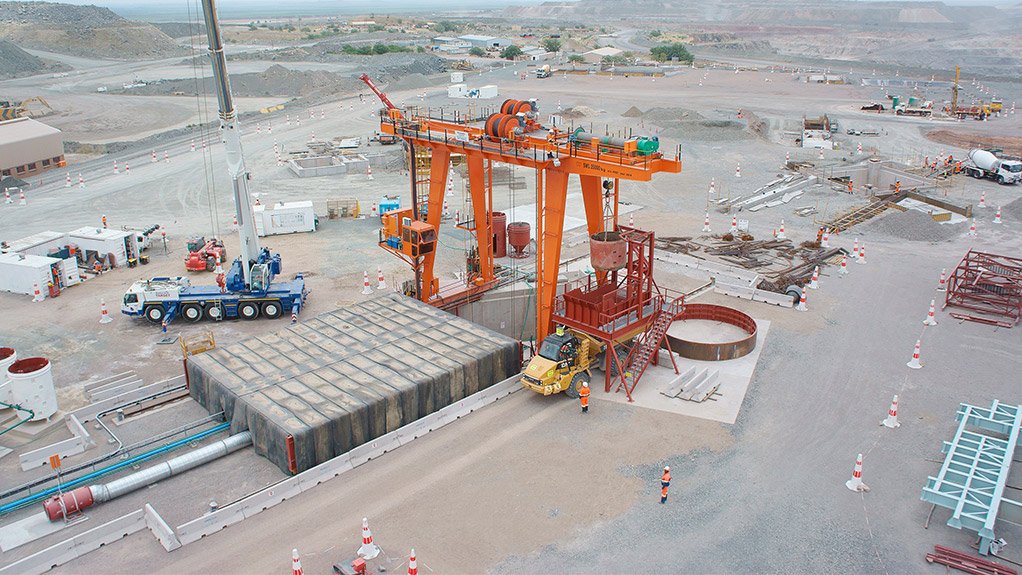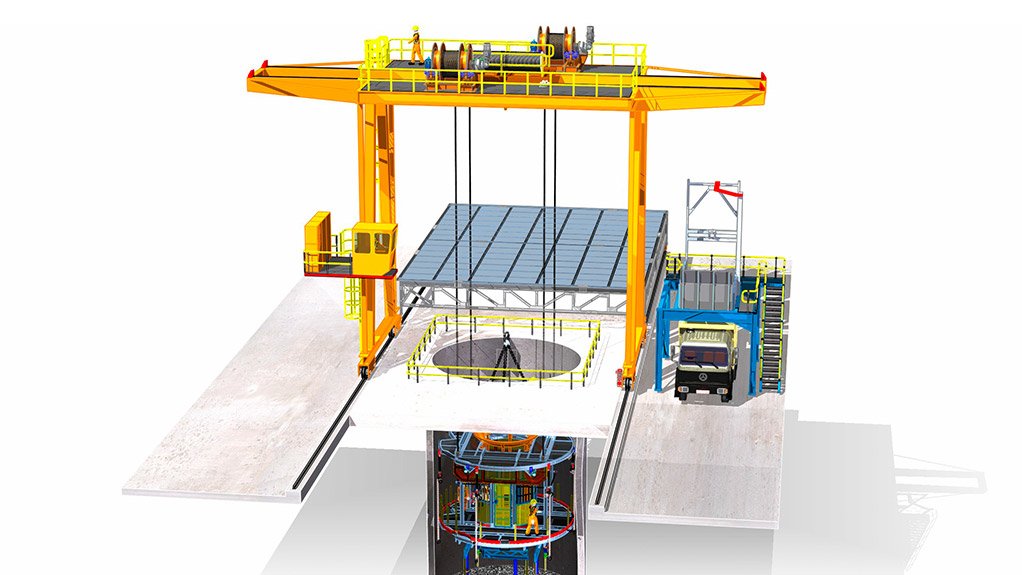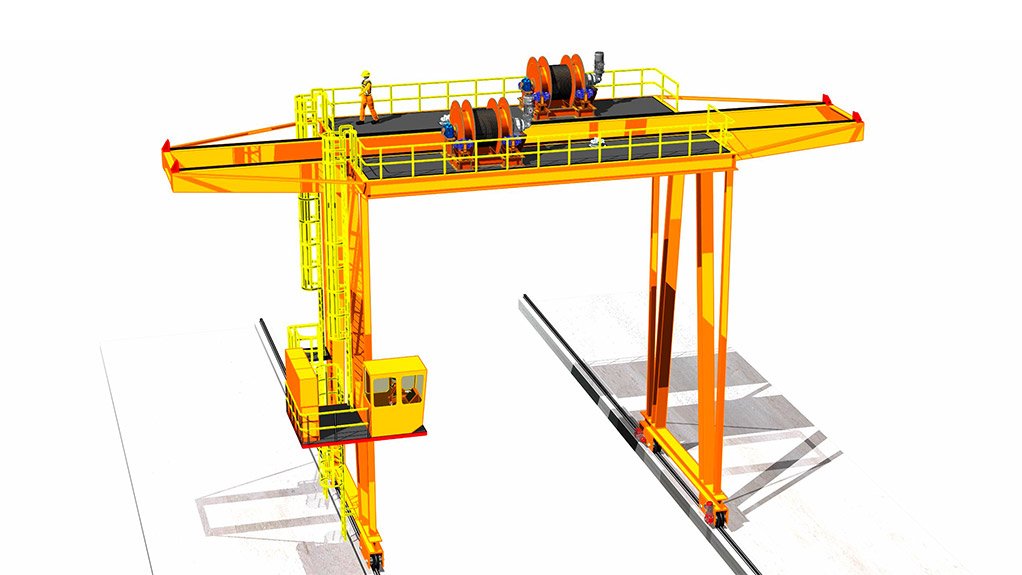Murray & Roberts Cementation Challenges The Status Quo
This article has been supplied as a media statement and is not written by Creamer Media. It may be available only for a limited time on this website.
Challenging the status quo in the mining industry is one of the characteristics that has allowed Murray & Roberts Cementation to develop innovative technologies aimed at enhancing safety and increasing efficiencies and productivity in this sector.
This often involves taking best practice components of methodologies used in other industry sectors, such as civil engineering and tunnelling, and adapting these to produce a new best practice technology specifically for the mining sector.
Allan Widlake, business development director at Murray & Roberts Cementation, says the most recent example of this is where the company leveraged its years of experience in shaft sinking.
Following extensive development work, the company’s team of engineers unveiled its innovative pre-sink gantry and this 21st century technology was successfully implemented at the Venetia Project.
This unique shaft sinking methodology is engineered to deliver optimal safe working conditions and comprises a single rail mounted gantry which combines the stage and kibble hoists as well as the blast barricade. The stage is suspended from the gantry on steel wire ropes attached to two 8 t stage winders on purpose-built platforms to the sides of the main girders.
Significantly attributing to the enhanced safety and productivity, man and material loading is handled on one side of the gantry with waste rock being dumped from the other side. “This is achieved with the gantry traversing between these two points,” Widlake says.
The main hoist of the gantry, used for kibble hoisting and slinging, was custom engineered to allow a pre-sink of up to 80 metres below the collar elevation. On the Venetia Project an actual depth of 60 metres below collar elevation was sunk.
The hoist is able to raise and lower a kibble with a 10 t payload at a conveyance speed of 0.5 m/s. The gantry system incorporates an automatic tipping frame. The kibble is slewed into its docking position where it is automatically positioned and hooked onto the frame. By lowering the hoist, the kibble’s payload is discharged into a truck waiting below.
Widlake says that this system significantly reduces risk thereby enhancing safe working and it reduces tipping cycle times resulting in increased productivity.
The height of the gantry structure is matched to the height of the stage and this allows the stage to clear the collar once raised to its upper limit. Once the stage has been raised in this upper position, the long travel wheel drive motors are energised to move the gantry, complete with suspended stage, away from the shaft. The blast barricade is then drawn over the excavation and this effectively prevents fly rock from leaving the shaft barrel during blasting.
After blasting and clearing the shaft of the blast fumes by means of forced ventilation, the gantry rolls back to its position over the shaft, and the fully equipped stage is automatically aligned and positioned using a fully integrated PLC, and then lowered back into the shaft to the required depth.
An innovation which further facilitates productivity applies to projects where more than one shaft needs to be sunk. The pre-sink gantry offers the ability to pull itself along the rails between the first and second shaft positions.
“Being able to rapidly move from the one shaft to the second during the pre-sink phase offers major time saving advantages and further reduces risk,” Widlake says. Traditionally set up for a pre-sink can take between one to three months but with this innovative technology it is now possible to achieve this over as little as two to three days.
Further innovations on the pre-sink stage include integral mechanised drilling systems. This consists of six vertical drill rigs supported on swivel arms suspended under the stage. Each operator guides the drill and manoeuvres it to match the pattern of holes required for the blast. An inline pneumatic air leg on the rock drill extends to create the necessary thrust between the stage and the floor and for drill retraction after drilling is completed.
“This technology has reduced the physical effort involved in the drilling operation and most importantly there are no longer any manual drill operators in the shaft bottom,” Widlake says.
The shaft lining process has also been simplified. A proprietary shuttering system is now suspended from the sinking stage. The shutter depth is 6 metres and after each 6 metre excavation the shutter is positioned 12 to 18 metres above the shaft bottom. This means that the shutter can be left in position during drilling and blasting operations.
“Importantly, the pre-sink gantry was not engineered for a single project and it is able to handle shaft pre-sinks from 6 metre diameters up to a large 10 metre diameter shaft,” Widlake concludes.
The innovative pre-sink gantry is set to change how shaft sinking is done on the African continent and is testament to the engineering excellence that resides within Murray & Roberts Cementation.
Comments
Press Office
Announcements
What's On
Subscribe to improve your user experience...
Option 1 (equivalent of R125 a month):
Receive a weekly copy of Creamer Media's Engineering News & Mining Weekly magazine
(print copy for those in South Africa and e-magazine for those outside of South Africa)
Receive daily email newsletters
Access to full search results
Access archive of magazine back copies
Access to Projects in Progress
Access to ONE Research Report of your choice in PDF format
Option 2 (equivalent of R375 a month):
All benefits from Option 1
PLUS
Access to Creamer Media's Research Channel Africa for ALL Research Reports, in PDF format, on various industrial and mining sectors
including Electricity; Water; Energy Transition; Hydrogen; Roads, Rail and Ports; Coal; Gold; Platinum; Battery Metals; etc.
Already a subscriber?
Forgotten your password?
Receive weekly copy of Creamer Media's Engineering News & Mining Weekly magazine (print copy for those in South Africa and e-magazine for those outside of South Africa)
➕
Recieve daily email newsletters
➕
Access to full search results
➕
Access archive of magazine back copies
➕
Access to Projects in Progress
➕
Access to ONE Research Report of your choice in PDF format
RESEARCH CHANNEL AFRICA
R4500 (equivalent of R375 a month)
SUBSCRIBEAll benefits from Option 1
➕
Access to Creamer Media's Research Channel Africa for ALL Research Reports on various industrial and mining sectors, in PDF format, including on:
Electricity
➕
Water
➕
Energy Transition
➕
Hydrogen
➕
Roads, Rail and Ports
➕
Coal
➕
Gold
➕
Platinum
➕
Battery Metals
➕
etc.
Receive all benefits from Option 1 or Option 2 delivered to numerous people at your company
➕
Multiple User names and Passwords for simultaneous log-ins
➕
Intranet integration access to all in your organisation























